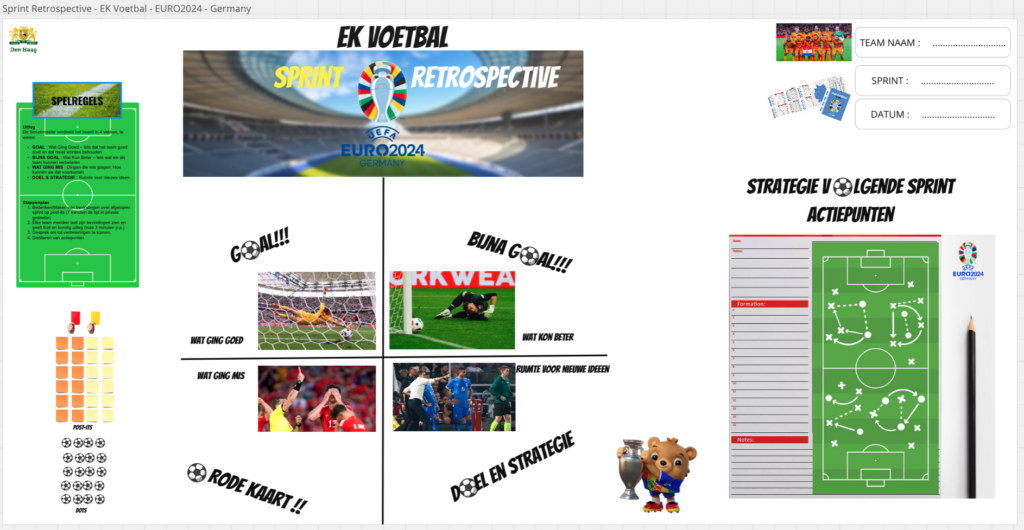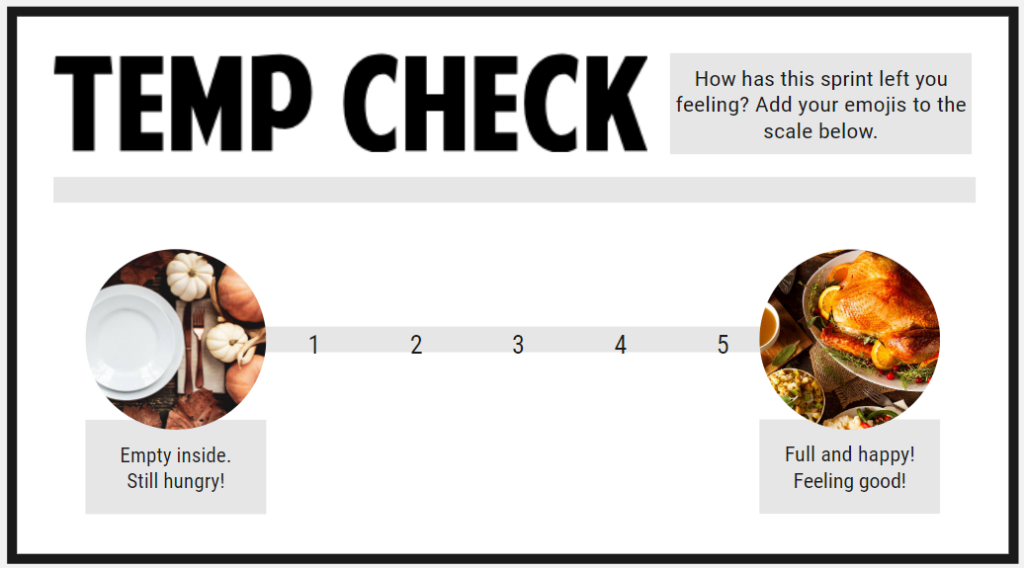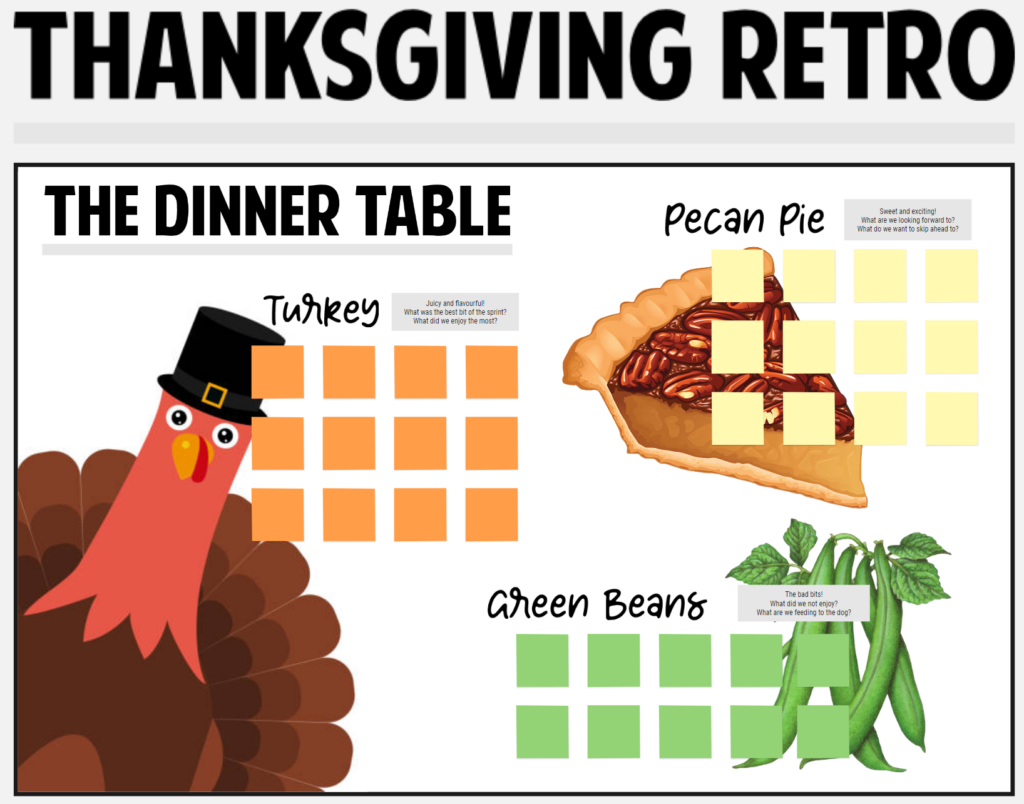
I made a nice annual overview in the form of a tear-off calendar from some sprint retrospective. Take advantage of it and if you have any suggestions of your own, let me know and I will add them.
Have fun with it…
General information
To conduct a successful sprint retrospective, follow these steps:
- Set the Stage: Create a comfortable and conducive environment for open discussion and
collaboration. Ensure all team members are present and actively engaged. - Establish Ground Rules: Establish ground rules to maintain a respectful and productive environment.
Encourage active listening, participation, and a focus on improvement, not blame. - Gather Data: Collect feedback from team members about the sprint’s successes, challenges, and
areas for improvement. Use various techniques like sticky notes, whiteboard brainstorming, or
anonymous surveys to gather diverse perspectives. The team typically discusses:
- How well the team members interact and communicate.
- Any impediments they’ve encountered.
- How well impediments were removed.
- If the Definition of Done still serves them as written, or if it needs to be updated.
- If there are any improvements to how the team works that can be implemented in future Sprints.
- Analyze and Prioritize: Analyze the gathered feedback to identify recurring themes, common pain
points, and areas for significant improvement. Prioritize these issues based on their impact and
potential for positive change. - Generate Actionable Ideas: Brainstorm and generate actionable ideas to address the prioritized
issues. Encourage creative thinking and consider solutions from various team members’
perspectives. - Establish Action Items: Select specific action items with clear ownership and deadlines. Ensure the
action items are measurable, achievable, relevant, and time-bound (SMART goals). - Document and Communicate: Document the key takeaways, action items, and decisions made
during the retrospective. Share the documentation with the entire team for transparency and
accountability.
My Template
I use the template below to collect all information

Week 1 (Special Day) • “New Year”
Week : 1
Name : New Year
Explanation : The Scrum Master divides the board into 2 main compartments:
Last Year Review
- Highlight: What was the highlight for you and as a team
- Learned: What do you remember about you and as a team have learned.?
- Goal/Ambition: Did you achieve last year’s goal/ambition?
Current year (Looking ahead)
- Ambition: What kind of ambition do you have and with the team
- Wish: What kind of wish do you have and with the team
Each column is subdivided into two subgroups:
- individually
- Scrum Team
Max 1 note per column
Example :

Week 2 • “Starfish”
Week : 2
Name : Starfish
Explanation : Use the Starfish to do a retrospective for a project, to build cohesive teams, to create focus
or to figure out what to do next. Have each team member add post its and thoughts to the following five
areas:
- Keep Doing – What are all the good things about the project or team or work in general? What do
people like to do or what do they like about the way things are? - More of – What are some of the things people want to do? What are the practices or methods that
people enjoy? - Less of – What isn’t helpful to the team? Which bits of the work are distracting or annoying, but still
required? What are some of the problems that don’t have clear solutions? - Start Doing – What are the ideas that might make things more enjoyable or profitable? What could
be done to solve problems or create momentum? - Stop Doing – What are practices or behaviours that don’t belong in the team or project? What
methods or tasks might be dropped completely?
Example :

Week 3 • “K.A.L.M.”
Week : 3
Name : K.A.L.M.
Explanation : The board is divided into 4 parts:
- Keep – something the team is doing well and whose value you recognize the value
- Less – something already being done, but of which you rather do less.
- More – something already being done which believe will bring more value if done even more.
- Add – a new idea or something you have seen working before that you would like to bring to the
table.
Example :

Week 4 • “PIZZA”
Week : 4
Name : PIZZA
Explanation : You can use this method to identify areas for improvement.
With 3 pizza slices that represent:
- What should we do more (MORE)
- What should we do less (LESS)
- What should stay! (KEEP)
Example :

Week 5 • “Fast Car With Parachute”
Week : 5
Name : Fast Car With Parachute
Explanation : Facilitator draws a fast car slowed down by a parachute. The motor of the car and the
parachute simulate the following:
- Engine: What has been pushing us forward? Making us move faster?
- Parachute: What has been slowing us down?
Example :

Week 6 • “W.W.A.”
Week : 6
Name : W.W.A.
Explanation : Facilitator draws a board what is divided into 3 parts:
Input Zone:
- What went Well during the Sprint
- What didn’t go well during the sprint.
Outcome Zone:
- After the submitted post-its are voted and discussed, they are moved and become action points
Example :

Week 7 (Special Day) • “Valentine Day”
Week : 7 (This week is Valentine day !!!! )
Name : Valentine Day
Explanation : Facilitator draws a board what contain :
- Temp Check : How did you feel about this Sprint.
- Heart with : What did you love this Sprint?
- Heart with : Who are you giving a rose to this sprint?
- Heart Broken : What left you heartbroken?
Example :

Week 8 • “Sailboat”
Week : 8
Name : Sailboat
Explanation : The idea is that the team is on a sailboat, heading towards their goal while dealing with
winds and icebergs along the way. Winds help propel the boat forward but obstacles such as pirates,
rocks, and stubborn anchors represent the risks that the team might encounter that could slow them
down or even stop them from getting to where they need to be.
- Boat: The Scrum team
- Sail: The things that helped us move forward (Wind, Cloud)
- Anchors: The things that held us back (Pirates, Rocks, Sharks, Icebergs, and Anchors)
- Island: The goals to be achieved
- Sun: What the team liked, the actions or attitudes that deserve thanks
- Reef: Represent future obstacles that have been identified, which the group is likely to encounter in the subsequent iterations.
Example :
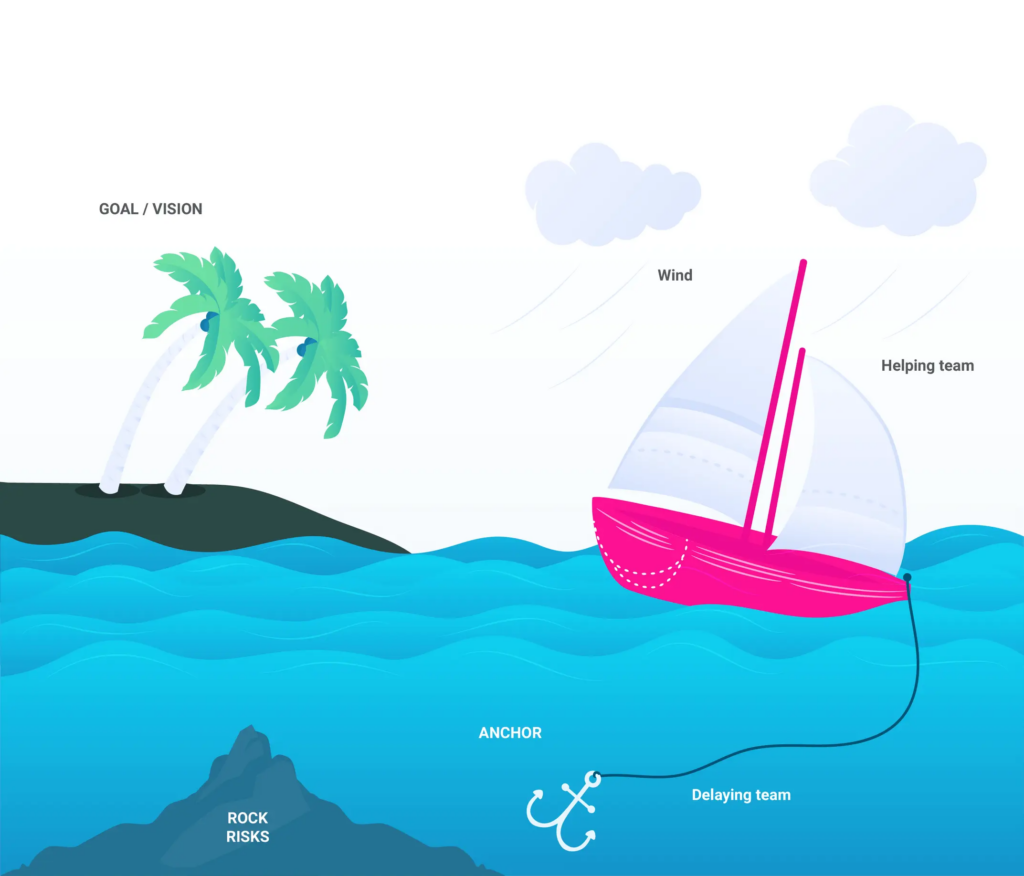
Week 9 • “W.W.W.W.”
Week : 9
Name : W.W.W.W.
Explanation : Facilitator draw on a board 4 quadrants that contain:
- What Worked Well?
- What Could Have Gone Better?
- What Do We Want do Try Next?
- What Questions Do We Have?
Example :

Week 10 • “Wishes”
Week : 10
Name : 3 Wishes
Explanation : Facilitator draw on a board 5 Zones:
Collect
- A Wish for Me
- A Wish the Project or Product
- A Wish the Team
Discusse
- Whises to Discuss after collect
Action
- Post’it becomes a Action item after discussion
Example :

Week 11 • “Festival”
Week : 11
Name : Festival
Explanation : Facilitator draw on a board 4 quadrants that contain:
- Main Stage – The things of the sprint, things that went well/we really enjoyed!
- Fortune Teller – Things you wish you’d know at the start of the sprint, on reflection.
- Action – How can we make next sprint better? What have our learnings taught us?
- First Aid Tent – Things that perhaps didn’t go as well as you’d of hoped.
Example :

Week 12 • “4L”
Week : 12
Name : 4L
Explanation : Facilitator draw on a board 4 quadrants that contain:
1. What did you like?
Ask “What did you really enjoy about this project or phase?” What went better than expected? Fill in the positive aspects of the project you’re reflecting on.
2. What did you learn?
Ask “What was a valuable lesson learned?”. Reflect on and share anything you might have learned. Learnings can vary from organisational to technical aspects.
3. What lacked?
Ask “What did you lack during this project or phase?” What could have gone better and was clearly
missing? Gather everything that held the team back and was a shortfall.
4. What did you long for?
Ask “What support did you desire or wish for?” Think future oriented, what’s something that you wish that
could exist going forward.
Example :

Week 13 (Special Day) • “Easter Egg”
Week : 13 (This week is Easter !!! )
Name : Easter Egg Retrospective
Explanation : Facilitator draw on a board 4 quadrants that contain:
- What were our tastiest Easter eggs – What were our positives? What went great?
- Which Easter eggs did you receive – How did we support each other? Dou you receive a helping
hand? - Are there eggas we’re still looking for? – Was we mis. What could be better
- Give Some eggs away. – Kudos to a person from the team
Example :



Week 14 • “WADE Matrix”
Week : 14
Name : WADE Matrix
Explanation : Facilitator draw on a board 4 quadrants that contain:
x-as : Can Control -Can’t Control
y-as : Went Well – Not So Well
- Quadrant. KEEP IT UP : The quadrant is intended for things that went well during the sprint and that
we could manage ourselves. - Quadrant. GO FIX : The quadrant is intended for things that want not so went well during the sprint
and that we could manage ourselves. - Quadrant. THANKS. : The quadrant is intended for things that went well during the sprint but is
manage outside the team. bring your thank you here !!! - Quadrant. ACCEPT OR ASK HELP : The quadrant is intended for things that want not so went well
during the sprint and that we can’t control. In this Situation where we can do 2 things: we make an
impediment and ask for help if necessary. Or we let it go if it doesn’t bring value
Example :

Week 15 • “Good, Bad & Ugly”
Week : 15
Name : Good Bad and Ugly
Explanation : Facilitator draw on a board 3 quadrants that contain:
- Good – what went well in the last sprint or in the last weeks, where did you have fun?
- Bad – what didn’t go so well, maybe even bad, in the last Scrum Sprint? What wasn’t so nice?
- Ugly – What was ugly, unpleasant, so that we should try to bring it into the “beautiful” realm? Where can we change the trend?
Example :

Week 16 • “D.A.K.I.”
Week : 16
Name : D.A.K.I.
Explanation : Facilitator draw on a board 4 quadrants that contain:
Drop
This is the opportunity for your team to voice what they would like to stop or remove. This could be
anything that affects their velocity and/or the quality of their work. For example, team members could ask
to do fewer meetings and to focus on their primary tasks.
Add
The Add section is the perfect place to be innovative. If your team members want to try new technology,
different processes or different ways to collaborate to achieve their goals, this is the right spot to
discuss it!
Keep
It’s time to make a team assessment. This part of the retrospective is the always-remember list. Keeping in
mind all the good ways to do things is great for your team’s velocity and pride!
Improve
Agile development focuses on incremental changes to deliver continuous value to your clients. Why
couldn’t we use this methodology to refine what your team does? What can we adjust to make it even
better?
Example :
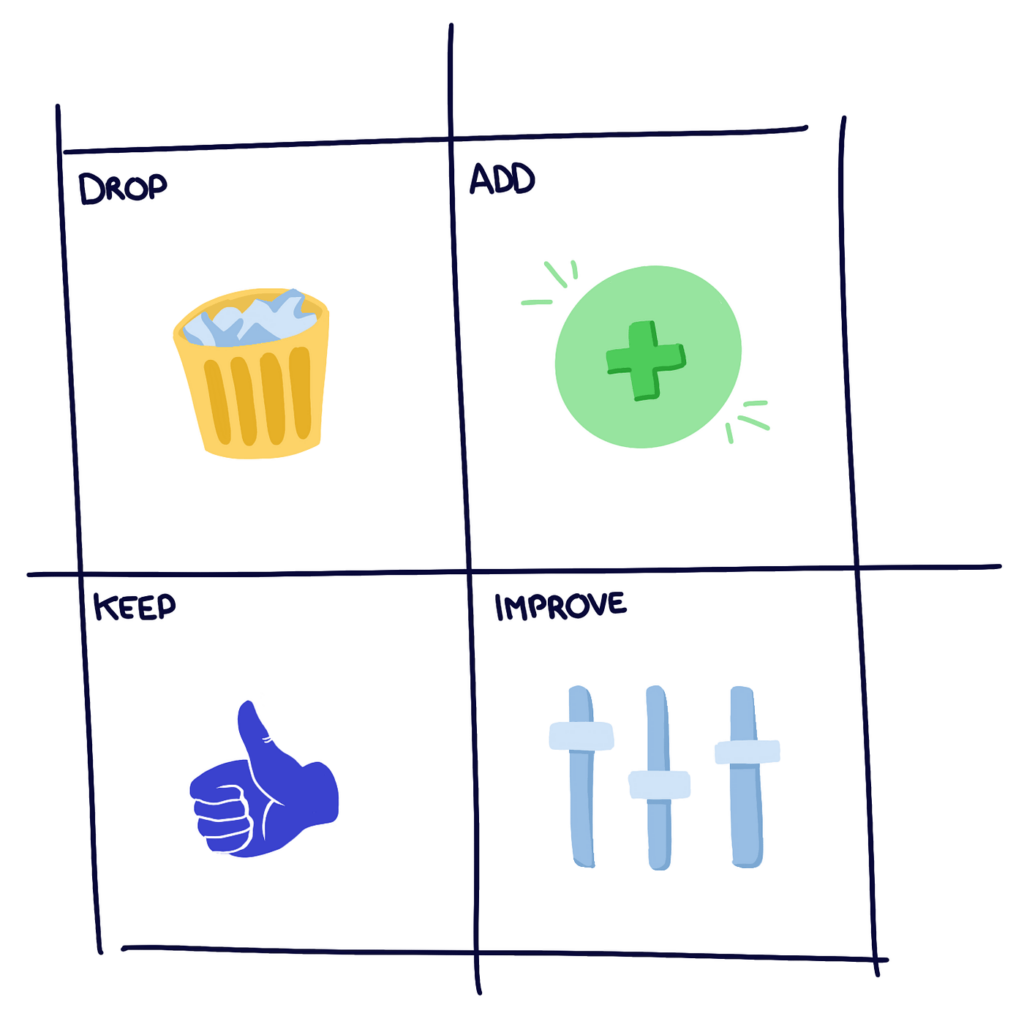
Week 17 • “Hot Air Ballon”
Week : 17
Name : Hot Air Ballon
Explanation :
The Hot Air Balloon retrospective is a reflective exercise, asking a team to raise and discuss what is helping
or hindering them on their project.
It combines backward-looking reflection into recent past activities, as well as forward-looking at what is
coming up for the team.
The hot air and sandbags represent what has been driving or holding back the team, while the storm
clouds and sunshine represent potential positive and negative events on the horizon.
This helps a team think of their recent work as a part of the whole project, not just in isolation. The team
think about how to improve based on their last sprint, but also look ahead to identify risks.
Example :

Source : Hot Air Ballon
Week 18 • “E.S.P.V.”
Week : 18
Name : ESPV
Explanation :
ESVP stands for ‘Explorers, Shoppers, Vacationers and Prisoners’. Participants are invited to indicate the
persona with whom they most relate at that point in time.
An ESVP focuses on four areas:
- Explorer – Will dive in and discover new things.
- Shopper – Will see what can be procured.
- Vacationer – Will relax and switch off.
- Prisoner – Does not want to be there.
Example :

Week 19 • “Observation & Actions”
Week : 19
Name : Observation & Actions
Explanation :
Observation (Sprint) : What was Good en What was Bad
Actions (For the Next Sprint) improvement : Do More, Do Less and Try
Example :

Week 20 • “Three Little Pigs”
Week : 20
Name : Three Little Pigs
Explanation :
Three Little Pigs is a fun retrospective activity that uses the Three Little Pigs story to foster a conversation
about improvements for making our structures more solid.
- Straw house – things that are unstable, weak, or might fall over at any point
- Stick house – things that are stable and will last a while, but could fall down under pressure.
- Brick house – a solid structure – things that are robust, or have been done very well.
Example :

Source : Three Little Pigs
Week 21 • “The Superhero”
Week : 21
Name : The Superhero
Explanation :
- Firstly, instead of the team listing absolutely everything they might be ‘good’ or ‘bad’ at, they are
now focusing on their SUPER POWERS – the super skills that make them special. Good for self-
confidence. - Secondly, the team will focus on their critical weaknesses – their kryptonite – that would stop
them saving the world. - Lastly, the team identify their superhero’s sidekick – recognising the people and skills that assist
them. Their ‘ally in the fight against evil’.
Example :

Week 22 • “Open The Box”
Week : 22
Name : Open The Box
Explanation :
“Inside this box there are all activities performed by the team. Please open the
box … “
- Which activities should be removed from the box?
- Which activities should be added?
- Which ones do we have to recycle?
Example :

Week 23 • “Start – Stop – Continue”
Week : 23
Name : Start Stop Continue
Explanation :
Start
Things that will have a positive impact on the team (or your own personal goals) that aren’t already
implemented.
This includes activities (behavioral, experimentation, improvements) that may:
- Improve existing processes or lead to the creation of a new process.
- Upgrade quality of your outcomes.
- Positively impact how you or your team feels.
- Improves how team communicates and collaborates.
Stop
Things that aren’t helping the team (or you) to achieve their goals and should be stopped. Stopping these
activities will free up time to do more impactful work.
This includes activities (behavioral and otherwise) that:
- Have a negative impact on the way team feels or the way things work.
- Wastes time and resources with inconsequential work.
- Inefficient practices or processes.
- Do not align with your goal and purpose.
- Distractions that eat into your time without adding value.
Continue
Things that are already working well and should stay to ensure future success.
This includes activities that:
- You and your team finds most fulfilling.
- Bring the biggest value / impact to your own goals or your team’s goals.
- Promote well-being and increase people’s motivations.
- Create a positive influence on work culture.
Example :
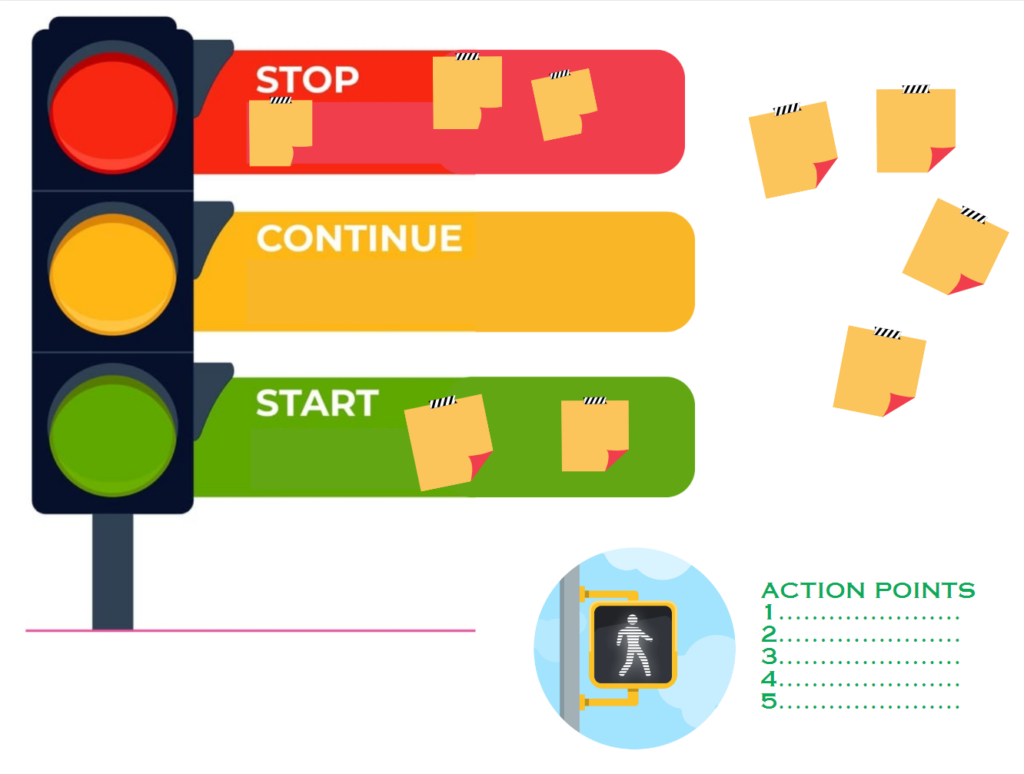
Week 24 • “Lean Coffee”
Week : 24
Name : Lean Coffee
Explanation :
- Draw a simple Kanban board with three columns : Todo, In Progress and Done. This board will help
the participants visualize the progress during the discussion. - After a quick introduction allow 5 minutes to the participants to individually brainstrom topic ideas.
Ask everyone to write a post-it note for each topic they want to discuss. - Everyone takes turn and quicky pitch his ideas: What topics they want to discuss and why. Each
topic ideas is added to the TODO column on the board. You have an overview of all the topics the
individuals want to talk about. - Each participant is granted two votes. Voting twice for the same item is permitted. Everyone gather
around the board and put a dot on their two favorites topics. - Add all votes and priorize/order the topics on the board: the most voted item will be discussed
first. If there’s a lot of ideas on the board some items probably did not received any votes: you will
not discuss those topics during the session. This is a great way to avoid boring discussion: you only
talk about what is interesting to the group. - Once you have a prioritized list of the topics you want to discuss, you can move the top item into
the In Progress column. - Set a timer to 5 minutes and you’re now ready to discuss the topic.
- Discuss the topic until the time is out !
- Have a silent roman vote: thumb up if you want to continue the discussion, thumb down if you want
to move to the next topic. If you have a majority of thumbs up : reset the timer and continue the
discussion. If you have a majority of thumbs down: move the topic to the Done column and move
to the next topic ! - At the end of the session take time to elicit key take-aways: what did we learn ? What actions can
we take ?
Source : Original Source
Example :
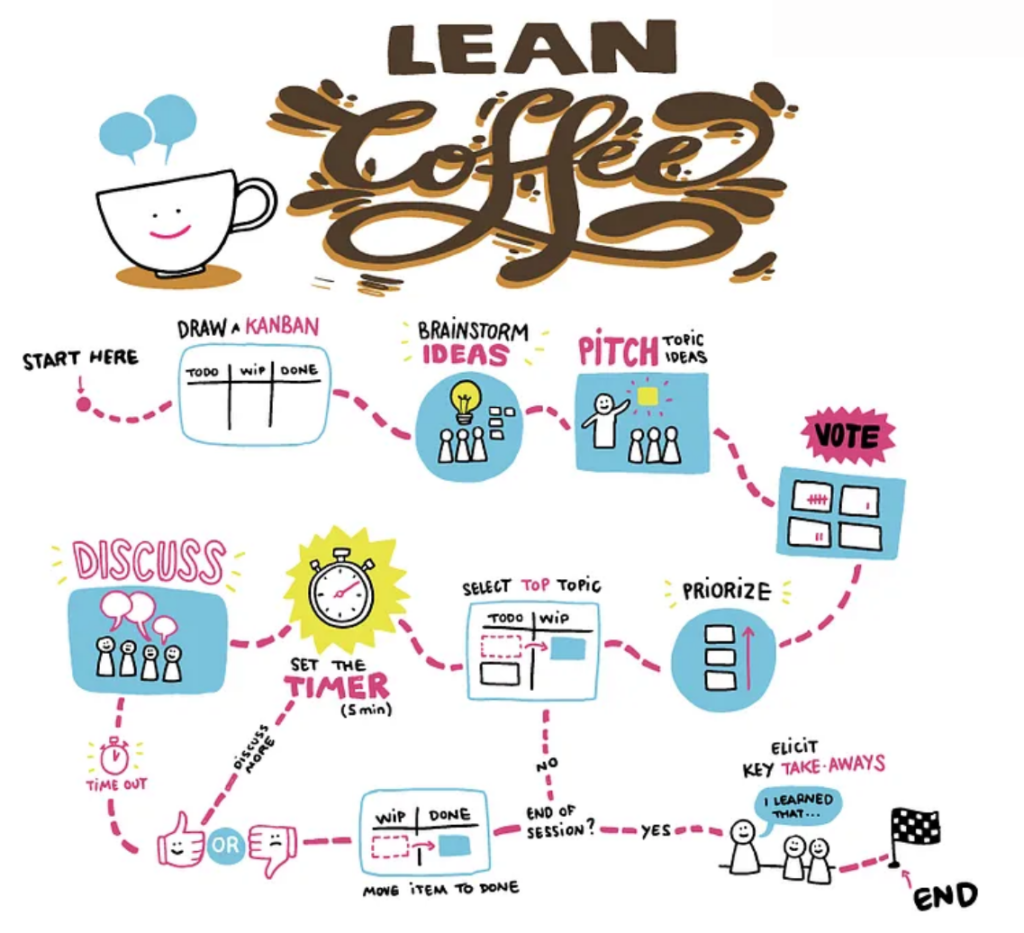
Week 25 • “W.R.A.P.”
Week : 25
Name : W.R.A.P. or W.A.R.P.
Explanation :
The WRAP or WARP retrospective as it is sometimes known, is an easy way to inject fun into the review of
your last sprint. It encourages the team to think about possibilities, expand their current state of mind, and
build rapport while keeping risk management in mind.
Wishes
This topic can produce some far-fetched ideas however, that is the point! What would make the ideal
sprint? What would make you most proud? Even if it’s a long-shot, what do you hope will happen?
Risks
What could slow things down or even completely derail things? What possible pitfalls or hazards should
be avoided? Are there threats or vulnerabilities that are yet to be addressed?
Appreciations
When did you feel grateful and who was it that made you feel this way? Who helped you? Who really
made a difference during the last sprint? Remember, these things don’t have to be project-related.
Puzzles
Is there anything perplexing you? Is there something you’re grappling with or seeking clarity on? Is there
anything you’re feeling doesn’t quite make sense?
Example :
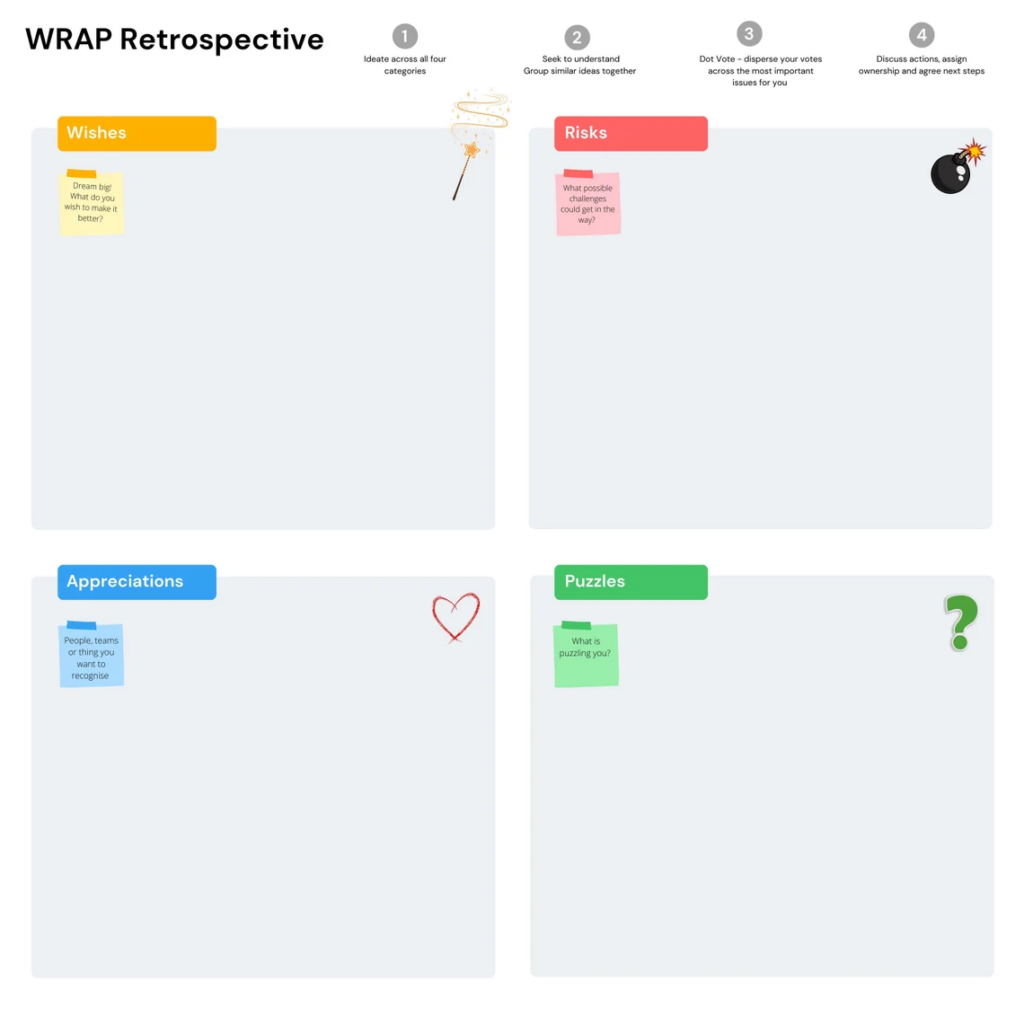
Week 26 • “Glad, Sad, Mad”
Week : 26
Name : Glad, Sad, Mad
Explanation :
A Mad Sad Glad retrospective is a simple and effective way for teams to reflect on their previous sprint. It
involves identifying things that made the team feel happy, things that made them feel sad, and things that
made them feel angry or frustrated.
Mad – List the things that are driving you crazy, frustrated, and annoyed. What is stopping you from
performing at your best? What activities have wasted their time?
Sad – What are some of the things that have disappointed you or that you wished could be improved?
Things that have not worked out as well as was hoped?
Glad – What makes you happy when you think about this project? What are the elements that you enjoy
the most?
Example :
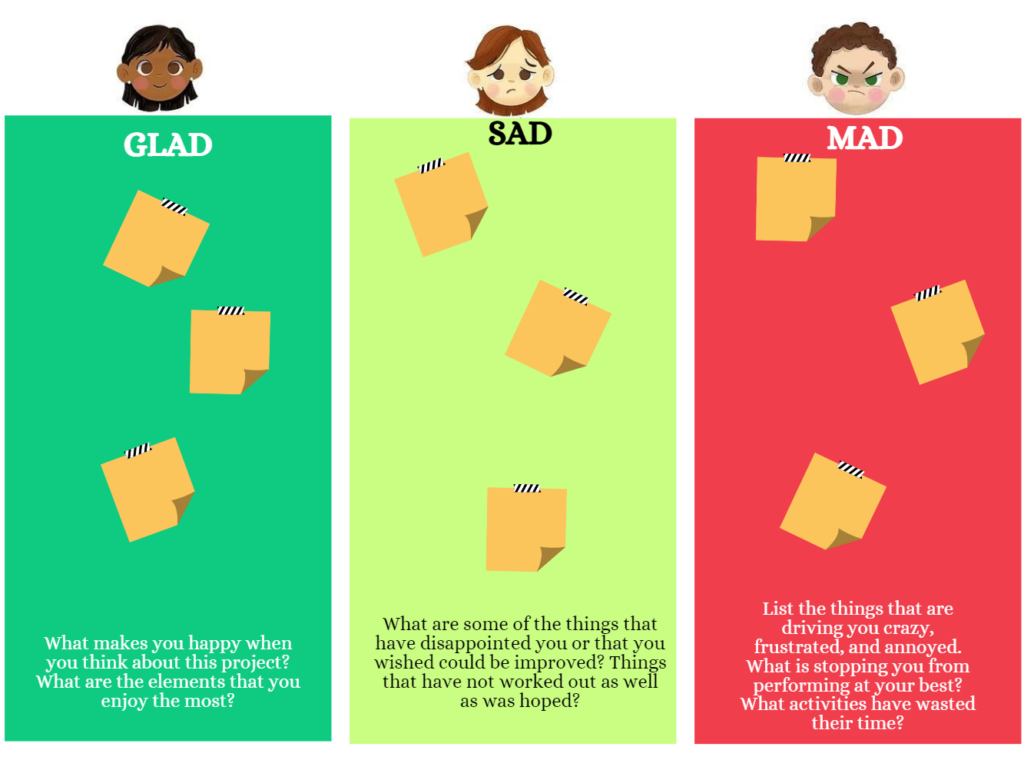
Week 27 • “F.L.A.P.”
Week : 27
Name : F.L.A.P.
Explanation : The FLAP Retrospective aims to help teams identify and address any issues that may have
arisen during the previous Sprint so that they can be addressed and resolved in future Sprints.
It is an acronym for Future Considerations, Lessons Learned, Accomplishments, and Problem Areas. This
retrospective is meant to be used at the end of a Sprint to evaluate considerations for future Sprints which
can boost team morale and productivity.
The structure of the FLAP retro is:
F: Future considerations – The team should focus on what they want to achieve in the next Sprint. The
team can do this by setting goals and objectives to reach in the future.
L: Lessons Learned – It is important for the team to learn from their mistakes to avoid repeating them. The
team should take time to reflect on what went wrong and how they can prevent it from happening again.
A: Accomplishments – The team should also take some time to celebrate their accomplishments, no
matter how small. This can help boost morale and motivate the team to do even better in the next Sprint.
P: Problems – The team should identify any problems that need to be addressed to improve their work.
Then, the team can brainstorm possible solutions and decide which ones to implement.
Example :
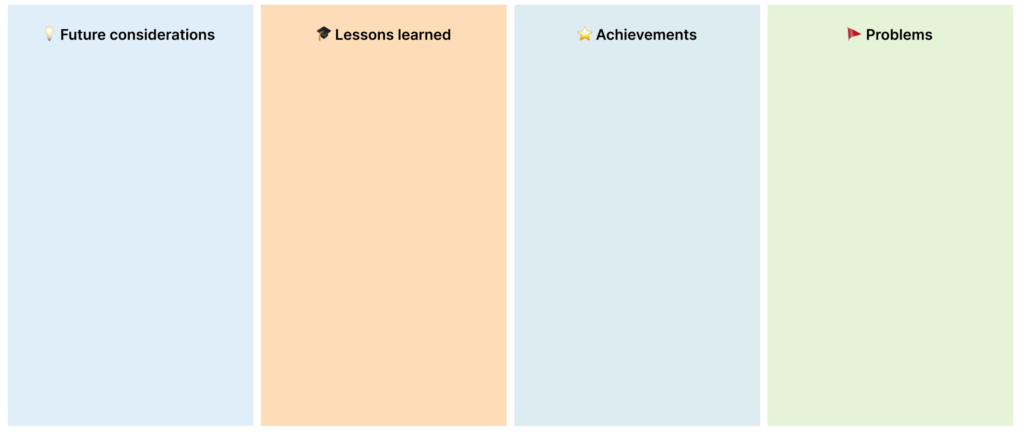
Week 28 • “Hot Potato”
Week : 28
Name : Hot Potato
Explanation :
Check-in: Select the potato representing your feelings about the last Sprint.
Check-in:
- Sweet potatoes grow during Sprints, where we meet new friends.
- Blue potatoes grow during Sprints where strange things lead to
unexpected outcomes. - Russet potatoes grow during Sprints, where everything goes as
planned. - Gold potatoes grow during Sprints, where we accomplish something
great.
The team starts by passing around a digital “hot potato” and sharing a story
related to the sprint. Each team member should make a reflection on the
last Sprint by choosing one of the following questions:
- What was a “hot success” during the sprint? What went well and made
you feel proud? - What was a “sizzling challenge” during the sprint? What was difficult or
frustrating? - What “spicy ideas” do you have for improving our processes or
outcomes? - What “flaming action items” are the problems that need to be
addressed from the last Sprint?
Example Check In:
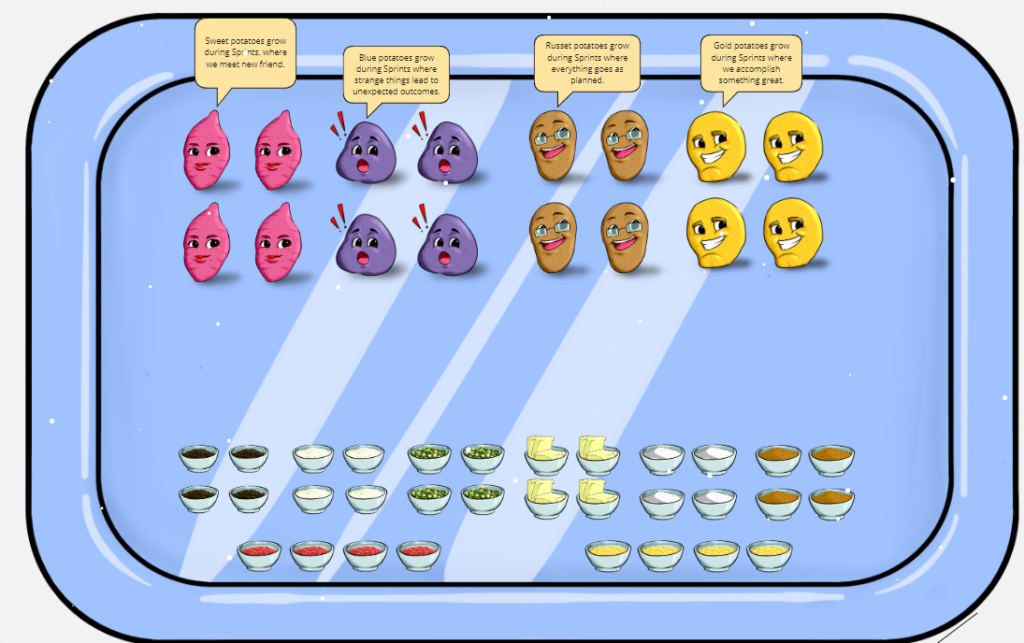

Week 29 • “The Weather Report”
Week : 29
Name : The Weather Report
Explanation :The Scrum Master will ask all the participants to draw on a post’it the weather that will define
their feelings during the last Sprint.
To guide them, he will give some indications:
Sunny
Meaning: Do you think that the sprint goals have been met? Do you feel positive and happy about your
contribution to the team’s outcome?
Cloudy
Meaning: What were the positive experiences you have had so far? Did things go well according to what
initially was planned? Did you have support from your colleagues?
Mix
Meaning: What challenges did you face during the project? Were you able to overcome it? How? What did
you do to solve the issues?
Rain
Meaning: What issues have you been confronted with? In your opinion, what stopped team productivity
to advance?
Example :
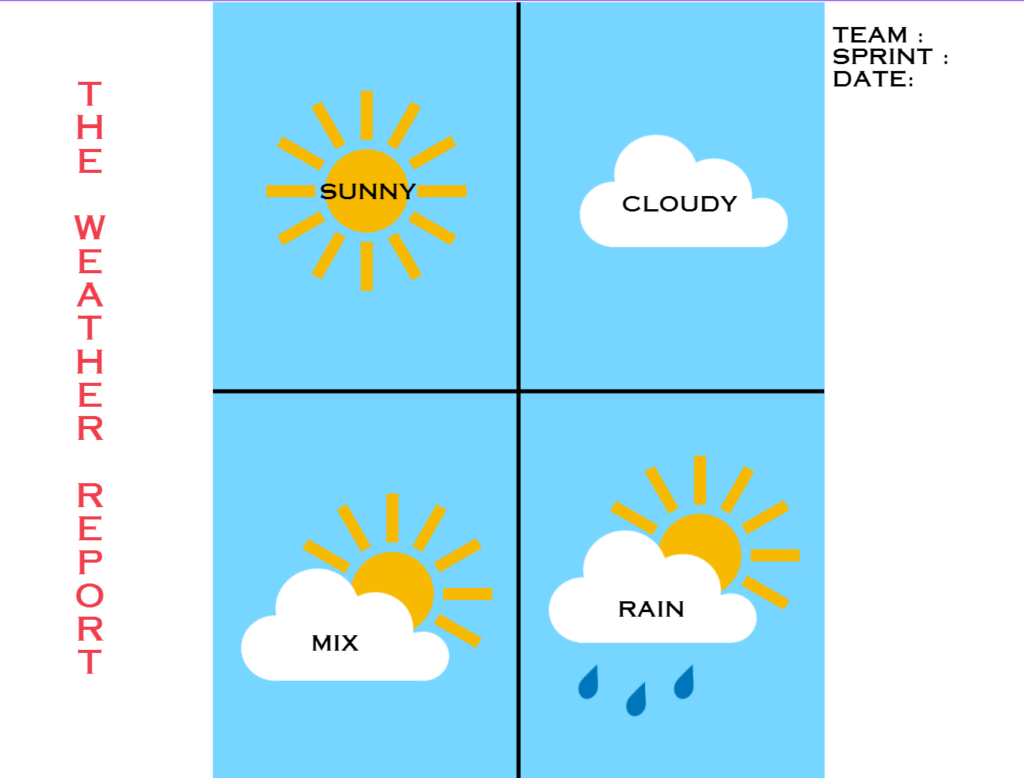
Week 30 • “Perfection Game”
Week : 30
Name : Perfection Game
Explanation : Perfection Game is the antidote to the usual kind of feedback. It works because it’s all
positive. In a Perfection Game retrospective, you reflect on your team and give your team a score from 1
to 10. Then you share a list of your team’s positive attributes-all the things that made them a good team
during the last sprint. Finally, you share a list of actions you could take together to make your team a
“perfect 10.”
Example :
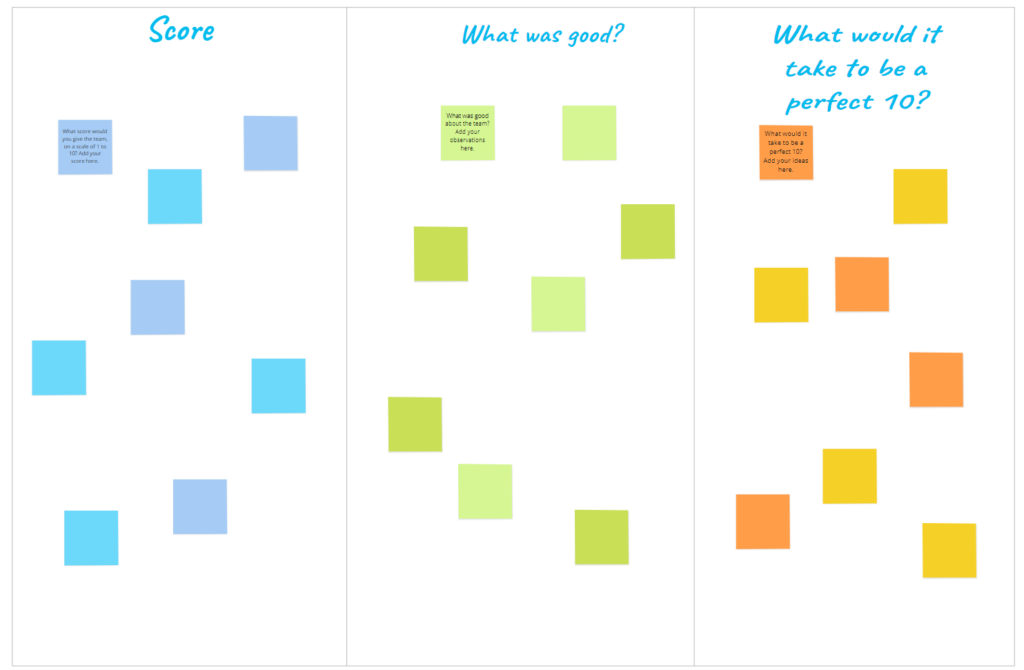
Week 31 • “Easy As Pie”
Week : 31
Name : Easy As Pie
- Humble Pie -Admit a wrong that occurred and apologize for the mistake.
- Shoo Fly Pie -Identify something negative that is hampering the team and you want to remove.
- Cutie Pie -Submit an appreciation for someone or something.
- Pie in the Sky -Present an idea that may be ‘impossible’ – a stretch goal, fanciful idea, or plan.
- Easy As Pie – Recognize something that was simple and pleasurable that you believe the team
should continue doing.
Example :

Source : Easy As Pie | FunRetrospectives
Week 32 • “Team of Heroes”
Week : 32
Name : Team of Heroes
Explanation : Each superhero symbolizes a certain observation that took place during the sprint:
- Hulk – What do we want to change?
- Iron Man – What experiments should we try?
- Captain America – What do we want to protect?
- Spiderman – How can we improve our team?
- Batman– What support do we need?
- Thor– What are our biggest strengths?
Example :
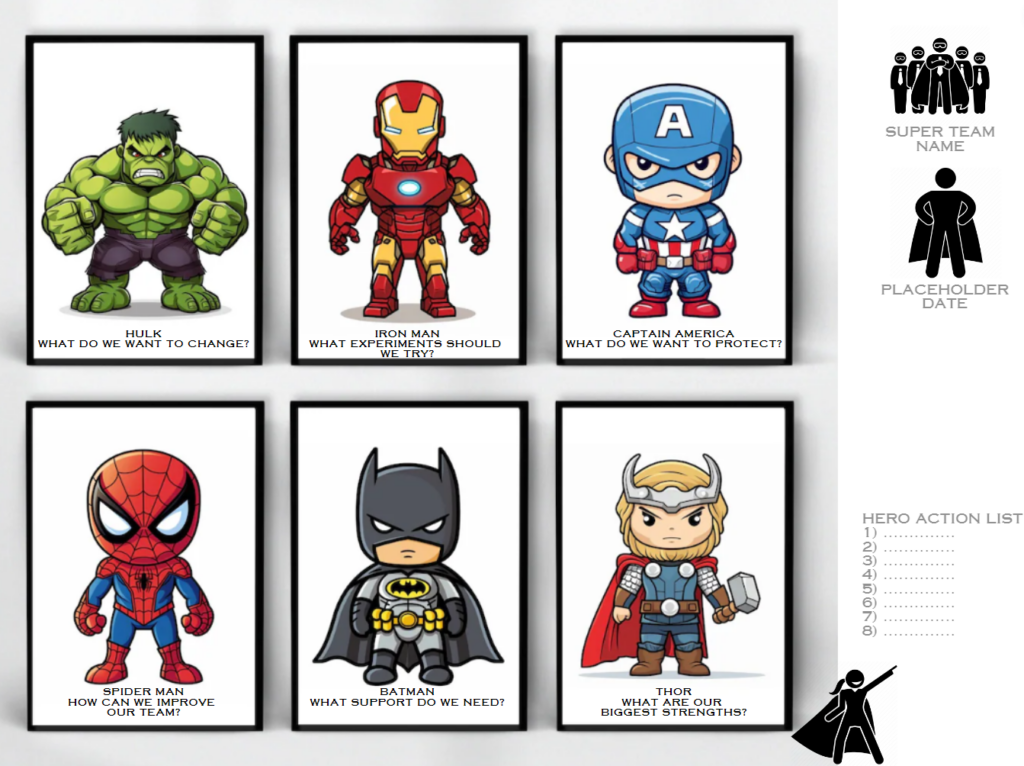
Week 33 • “Formula 1”
Week : 33
Name : Formula 1
Explanation : The formula 1 car symbolizes the scrum team on its way to the finish. During the race (read
Sprint) the team is slowed down or stopped due to certain circumstances. Below is an explanation:
- Parachute: What slowed us down
- Car: What were some things that went well?
- Stop sign: what stopped us in what we were doing
- Finish line: what are we going to celebrate, what were the things that went well
Example :

Week 34 • “Battery Energy”
Week : 34
Name : Battery Energy
Explanation :
- Fully Battery : What energized you in the last sprint?
- Medium Battery : What took up the right amount of energy in the last sprint?
- Low Battery : What drained you in the last sprint?
- Re-charge : What will re-energize you for thr next Sprint?
Example :
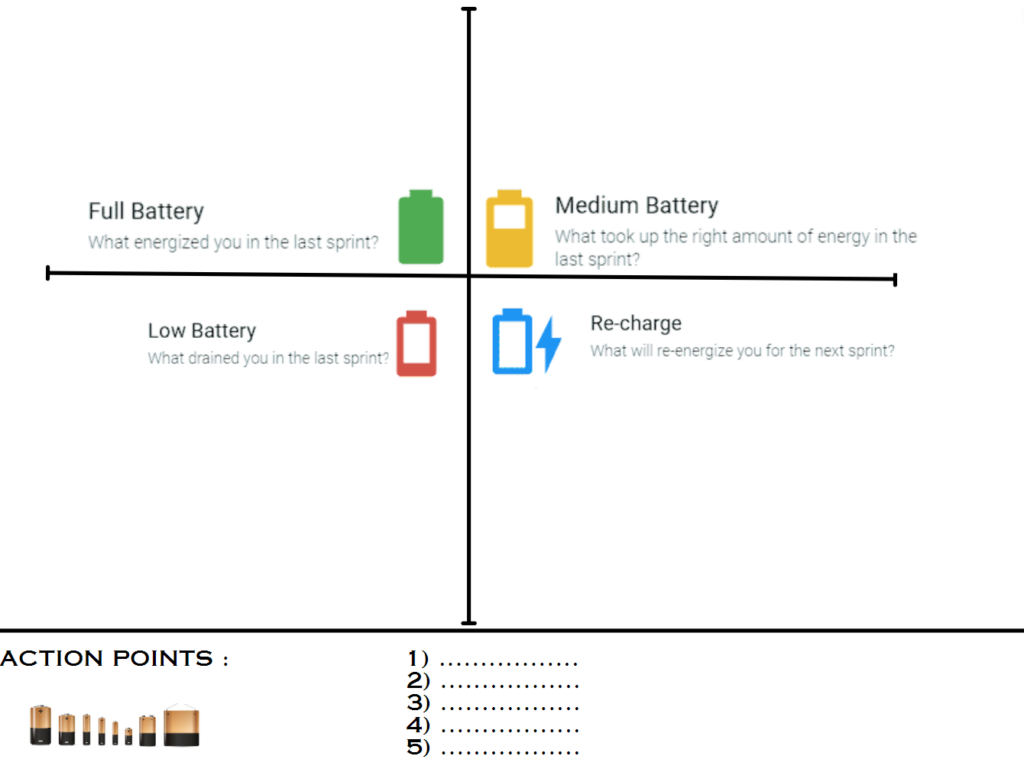
Week 35 • “Kudos Tree”
Week : 35
Name : Kudos Tree
Explanation :
Work can get super hectic and it’s easy to forget all the awesome things our coworkers do for us. So take
a moment to give thanks where they’re due. The Kudos Tree helps a team show appreciation for each
other and share some positivity.
Spend five minutes at the beginning of the next meeting writing a thank you note or to mention
someone’s great work. It’s nice to be appreciated.
How to use the Kudos Tree template
- Reserve 5 minutes of the start of the next meeting to writing kudos cards.
- Everyone writes their notes in private, then shares with the group when ready.
- People can choose to expand on their note if they wish.
Example :
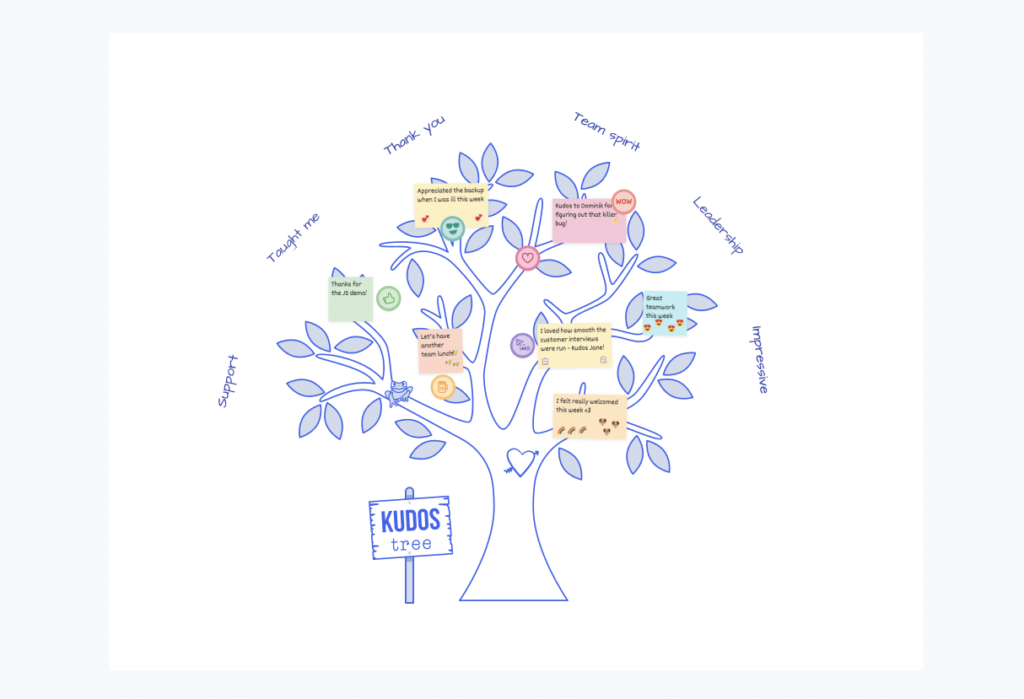
Week 36 • “Rose Bud Thorn”
Week : 36
Name : Rose Bud Thorn
Explanation :
The Rose, Thorn & Bud Check-in is a simple but mindful way to reflect upon recent events. It is a versatile
exercise that you can use at the beginning of a meeting or as a retrospective.
There are three sections to the activity, two backward-looking and one forward-looking:
Rose – What are you grateful for, or what is a positive?
Thorn – What is challenging or stressful, and you could use more support on right now?
Bud – What are you looking forward to, or what gives you hope, inspiration or motivation right now?
Example :
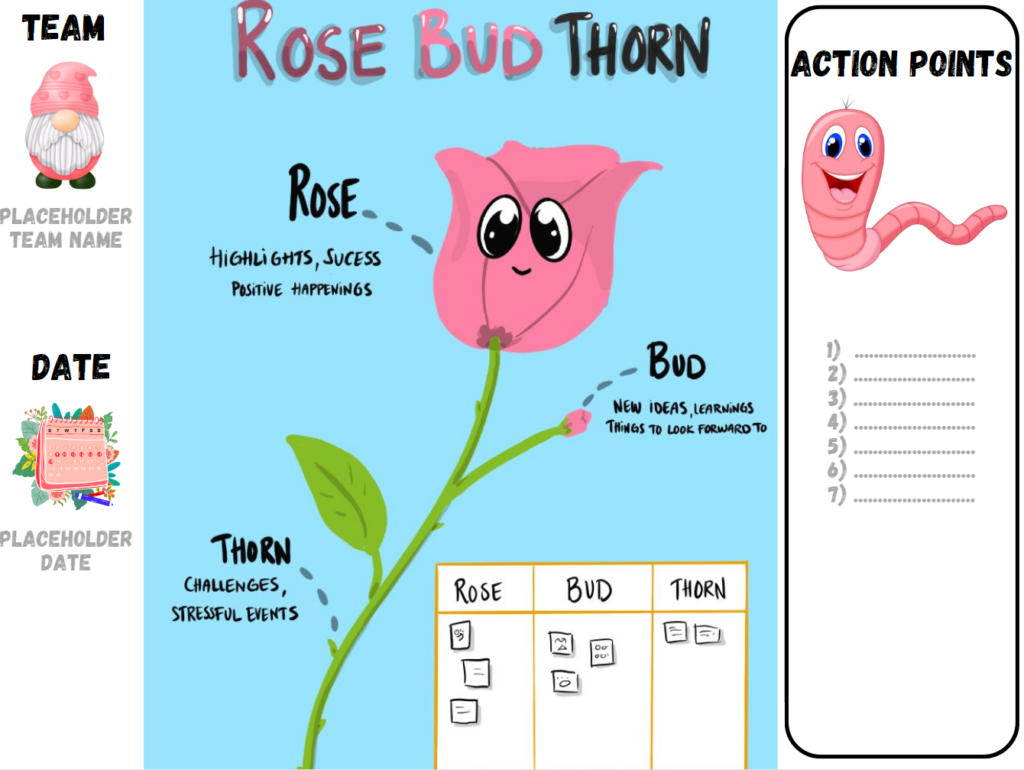
Week 37 • “LEGO”
Week : 37
Name : Lego
Explanation :
Build 3 things with Lego to symbolize how certain activities went within the sprint
Usage :
- Lego Building Blocks green: For something that went great during the sprint
- Lego Building Blocks orange: For something that could be improved during the sprint
- Lego Building Blocks red: for something that didn’t go well
You will have +/- 7 minutes for each part. You can then give your explanation briefly and concisely to the
team.
Example :
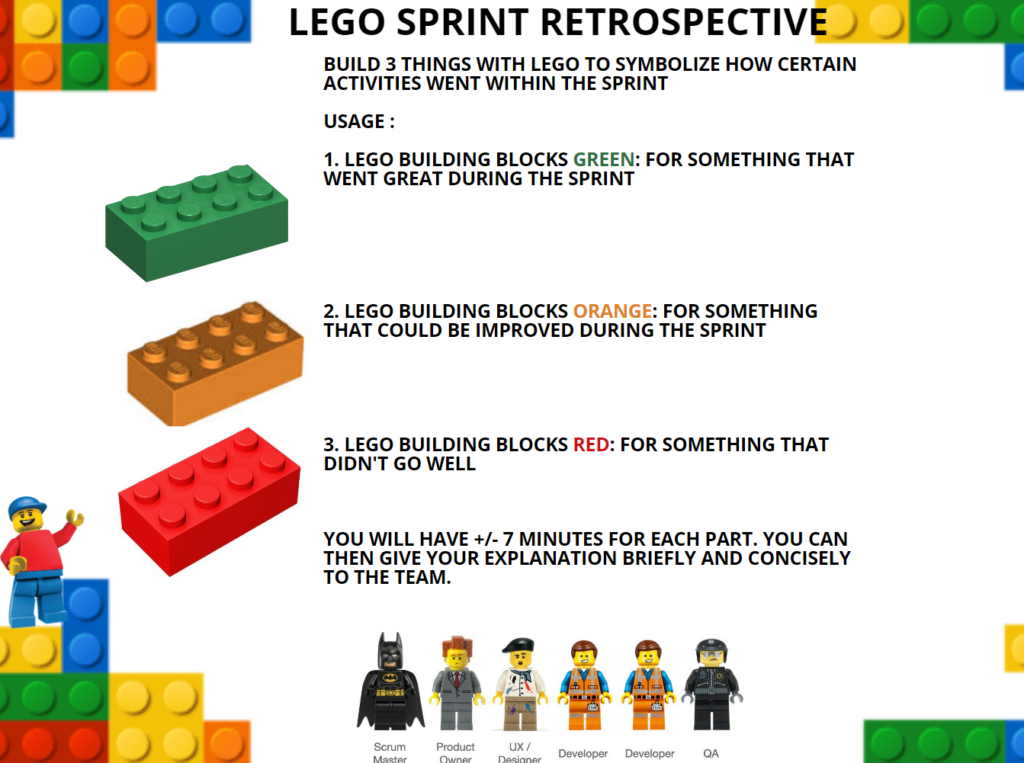
Week 38 • “The Band”
Week : 38
Name : The Band
Explanation :
Just like after any performance, the team needs to debrief! Give your team a band name (or even better,
decide on one together) and dedicate roles to each member of the group. This exercise alone is sure to
get people out of their shells, escaping the monotony of previous retros with an fun twist.
How to conduct the retrospective (4 steps):
- The Scene: describe how the band performed in the last “show” (your sprint). Be objective here. Were
goals reached, did everything go live on time, is the Sprint successfully done? - Backstage: What did you notice about what went on behind the scenes? For a band that might be
equipment set up, and for your team, it might be team processes such as QA. Everything leading up to the
“big event” matters in making it successful, and there is always room to optimize. - The Road Crew: Get human! Highlight who helped the group and be specific in how they made an
impact. This will boost team morale and engagement. - The Setlist: Looking back on the performance overall, discuss how you can improve for the next Sprint.
This is where your action items come in! Be sure to note them and assign owners for each item to ensure
there’s accountability.
Example :
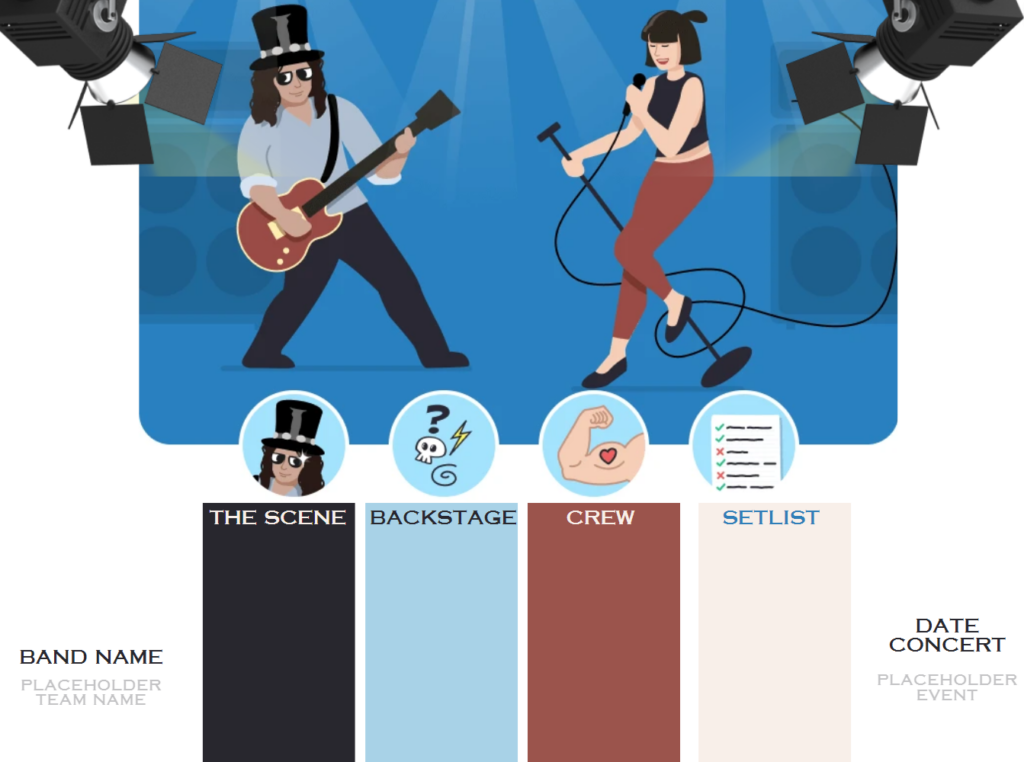
Week 39 • “S.W.O.T.”
Week : 39
Name : Swot
Explanation :
Getting a team together to work on a project can be overwhelming. Luckily, the SWOT retrospective idea
breaks the ice among team members and gets the team to work proactively on the new project.
The SWOT sprint retrospective assesses the team’s strengths and weaknesses, along with the project’s
opportunities and threats. The retrospective is divided into four quadrants:
- Strengths are attitudes and behaviors that worked in the past
- Weaknesses consist of any attitudes or behaviors that did not work in past projects
- Opportunities allow the team to improve
- Threats are risks to consider when taking on the project.
Example :

Week 40 • “Mountain Climber”
Week : 40
Name : Mountain Climber
Explanation : The Mountain Climber retrospective template is another visually engaging technique. In this
template, you will discuss how different elements affected your ability to reach your sprint goals,
represented by:
- Boulders: What obstacles did we face during the last sprint?
- Climbing equipment: What helped us on the climb towards our goal?
- Inclement weather: What posed a delay, setback, or disruption?
- The summit: Did we reach our sprint goal?
Example :
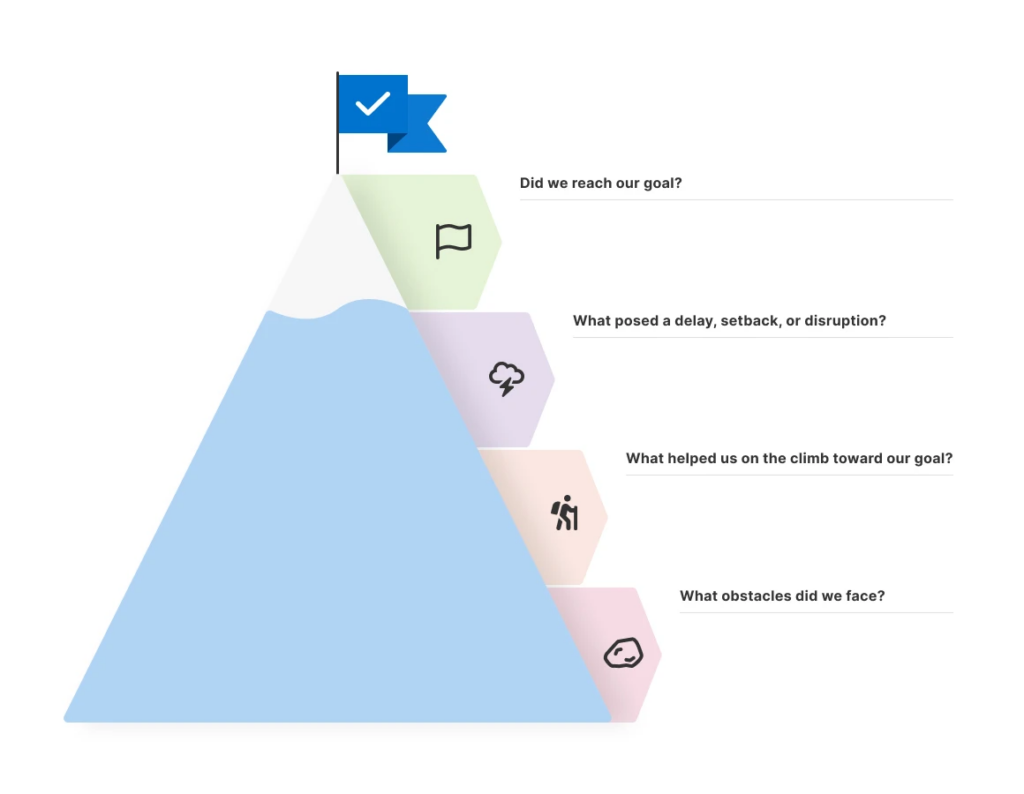
Week 41 • “M&M’s”
Week : 41
Name : M&M’s
Explanation :
The Scrum Master puts the contents of a bag of M&Ms in a closed box. Then, one by one, each member
of the Scrum Team is invited to take an M&M out of the box.
The color of the M&M represents a category of questions that require an answer.
After answering the question, the M&M can of course be eaten!
The Scrum Master puts the contents of a bag of M&Ms in a closed box. Then, one by one, each member
of the Scrum Team is invited to take an M&M out of the box.
The color of the M&M represents a category of questions that require an answer, for example:
Brown: What went well, what should we continue to do?
Red: What went less well, what should we stop?
Yellow: What is a new idea that we should start immediately?
Green: What activity should we do more of?
Blue: Which activity should we do less of?
Orange : Get another One !!!!! (BONUS)
Example :
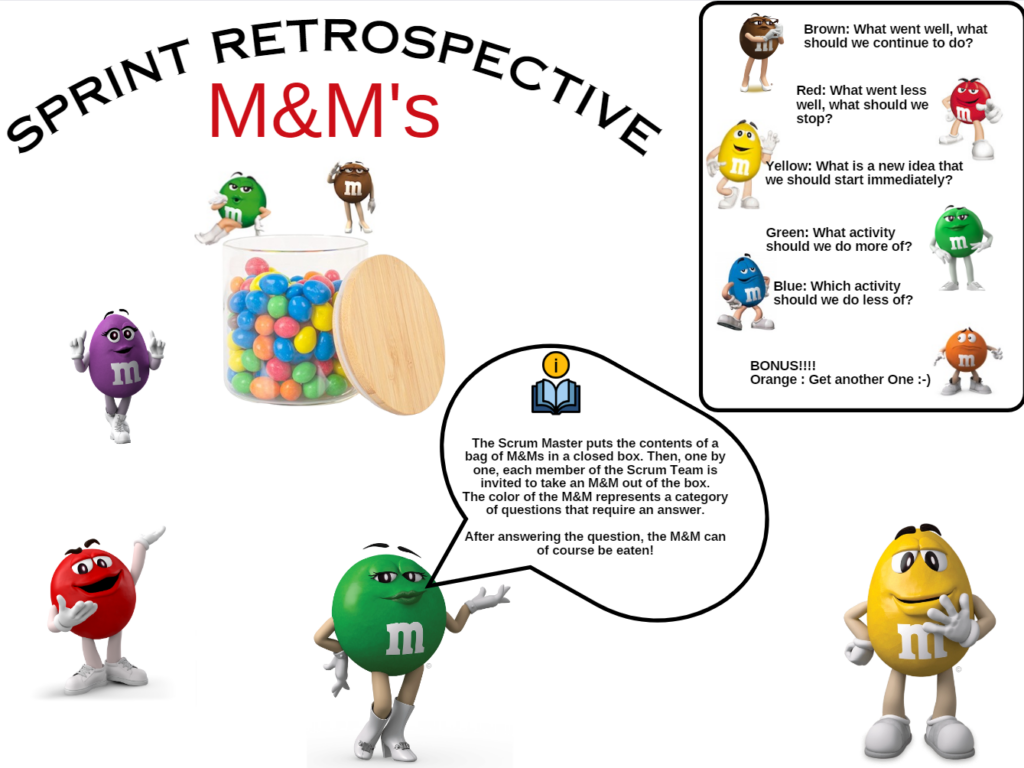
Week 42 • “Hero’s Journey”
Week : 42
Name : Hero’s Journey
Explanation :
Hero’s Journey
- The hero : who is the person or the group going through the journey
- The guide : the people and things guiding the hero
- The cavern : the challenges ahead
- The inventory : The Tools resource avilable
- The treasure : the awards and achievements
Example:
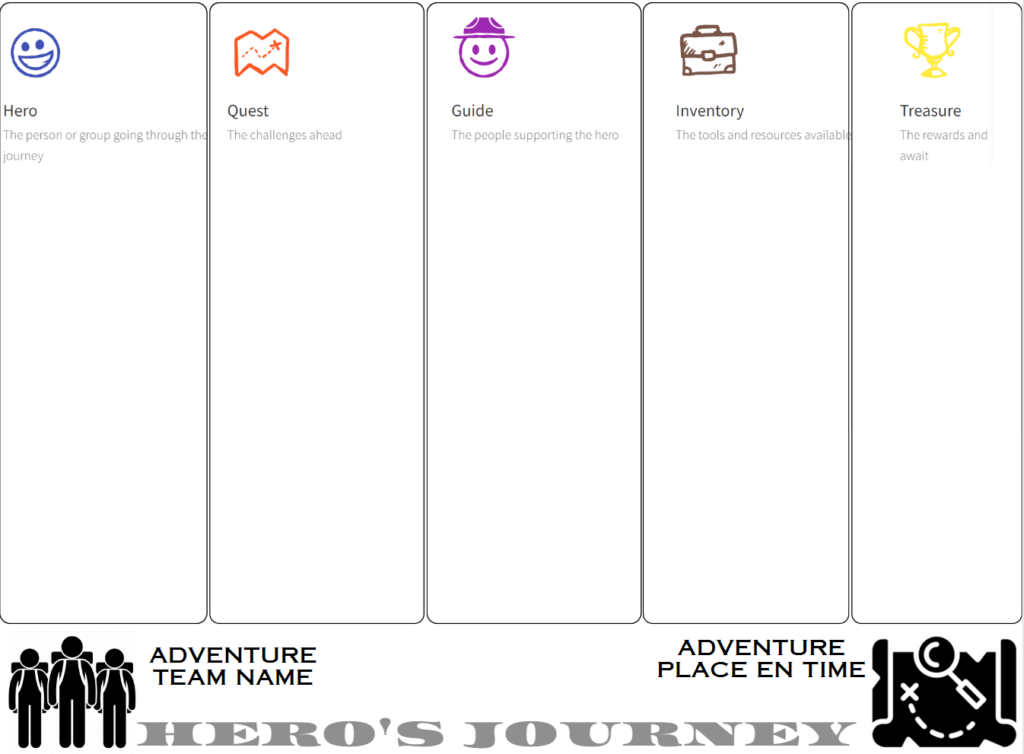
Week 43 • “What? So What? Now What?”
Week : 43
Name : What? So What? Now What?
Explanation :
What?
How would you describe the situation? What happened? What was observed? What did you do to
contribute? What was predicted? What was unpredicted?
So What?
How does this affect us? What value was delivered? What was learnt?
Now What?
What do we need to do to move forward? What can be repeated? What is to be avoided?
Example:
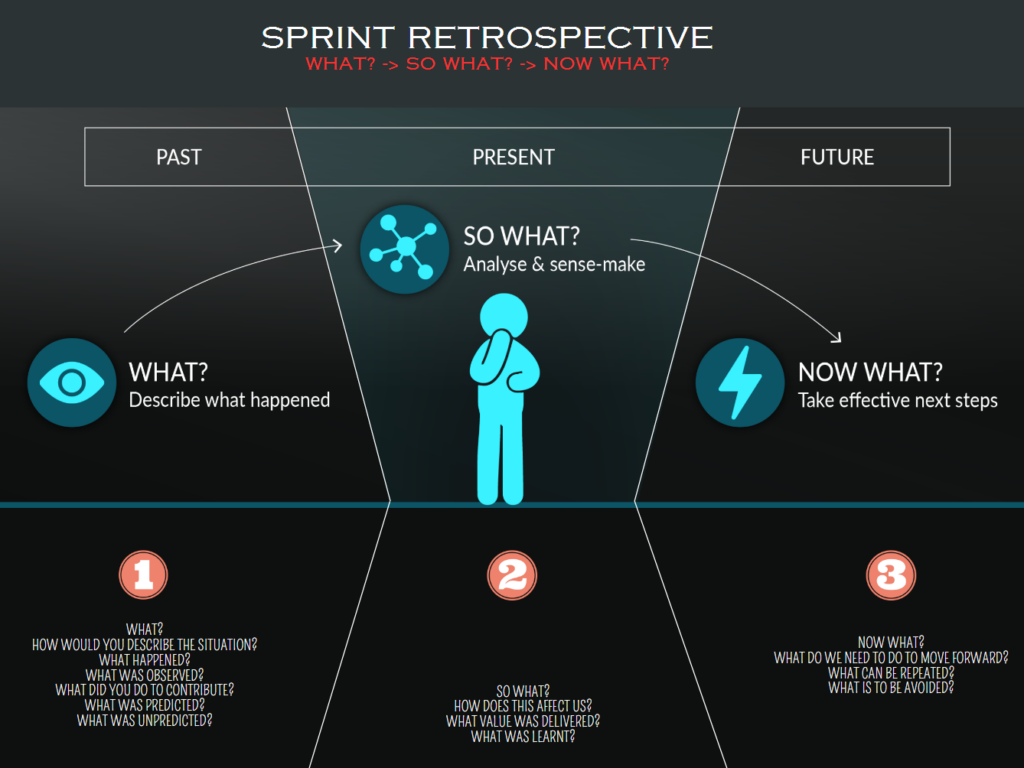
Source : Read this article
Week 44 (Special Day) • “Halloween”
Week : 44
Name : Halloween
Explanation : Request the team members to use sticky notes for each area:
- Tricks (Challenges)
- Treats (Successes)
- Ghosts (Things we should leave behind)
- Witches’ Brew (New ideas).
Conduct the Retrospective
1. Introduction (5 minutes): Set the tone by explaining the Halloween theme and the retrospective process. Encourage participants to embrace the spirit of Halloween.
2.Tricks (15 minutes): Ask participants to share challenges or obstacles faced during the project or time period. Have them write each challenge on a sticky note and place it under the “Tricks” category on the board.
3. Treats (15 minutes): Shift the focus to positive aspects. Invite participants to share successes and achievements. Place these notes under the “Treats” category on the board.
4. Ghosts (10 minutes): Discuss things that didn’t work or should be left behind. Encourage open and honest communication about what should be “ghosted” from future endeavors.
5. Witches’ Brew (15 minutes): Brainstorm new ideas and improvements. What can be added to the “brew” to enhance future projects or processes? Collect these ideas under the “Witches’ Brew” category.
Step 4: Reflect and Plan
Reflect en Plan
1. Group and Discuss: Group similar sticky notes together and discuss patterns or common themes that emerge from each category.
2. Action Items: Identify action items based on the discussions. What steps can be taken to address challenges, build on successes, and implement new ideas?
Closing
1. Express Gratitude:Thank participants for their contributions and creativity.
2. Celebrate Halloween:If possible, end the retrospective with a small celebration, like sharing Halloween treats or playing a spooky game.
Remember to adapt the timing and activities based on the size of your group and the available time.
Most importantly, have fun and encourage everyone to engage in the Halloween spirit!
Example :
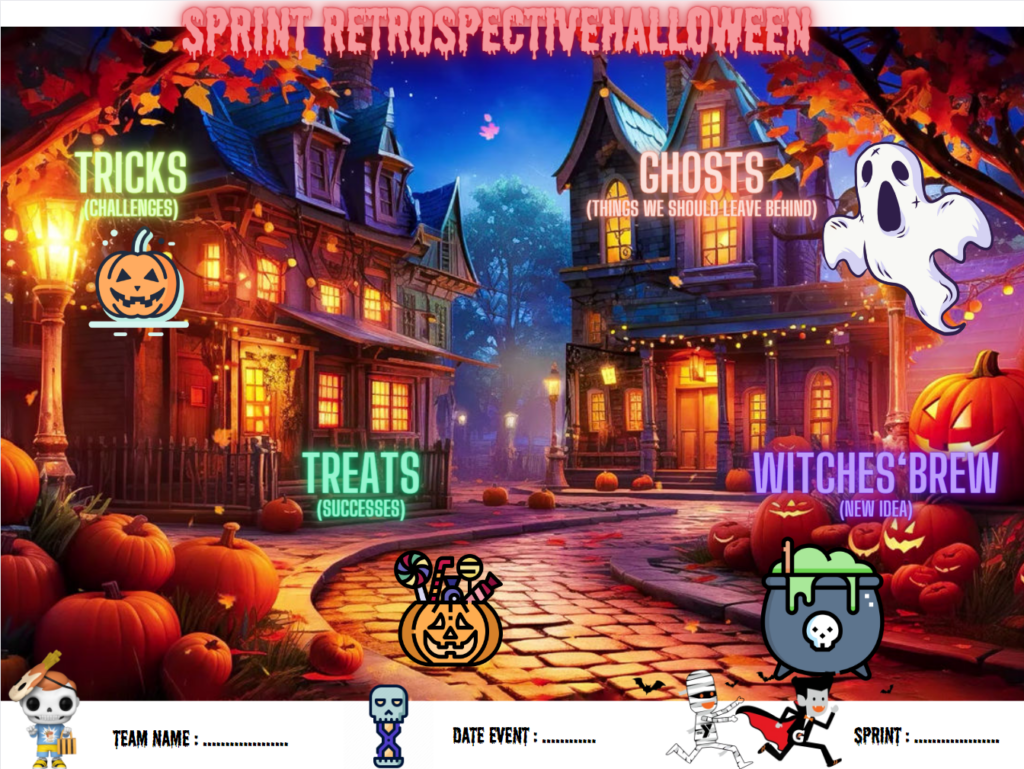
Week 45 • “Fast & Furious”
Week : 45
Name : Fast & Furious
Explanation : Request the team members to use sticky notes for each category:
- Fast: things that went very fast;
- Furious: things that made you furious;
- Fun(ny): things that were fun or funny;
- First: things that you learned & kudos;
- Fed up: things that you really annoyed you and want toget rid off.
Example :
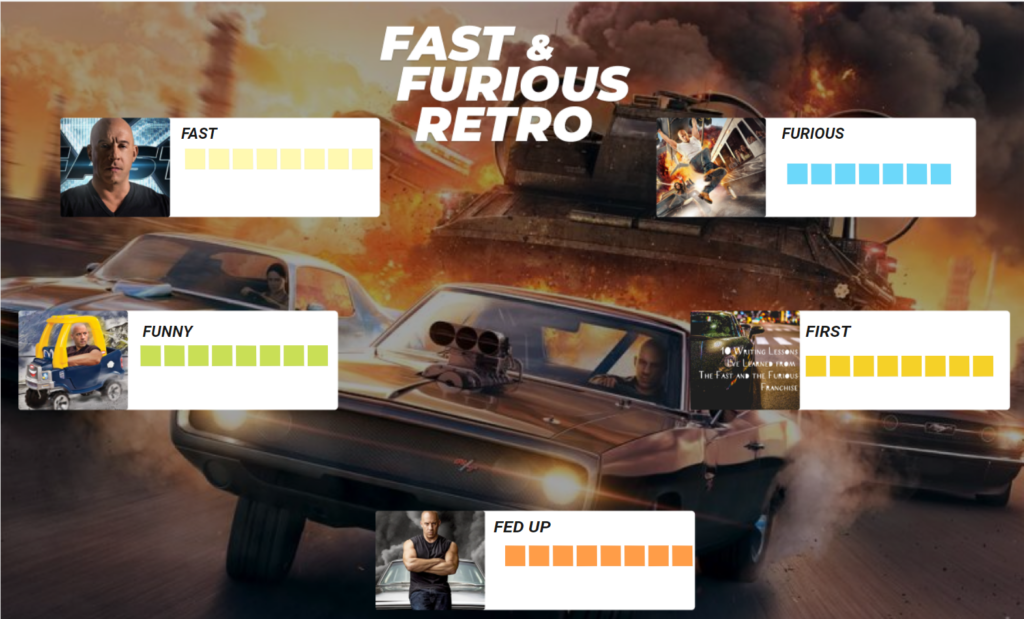
Week 46 • “Focused”
Week : 46
Name : Focused
Explanation : Request the team members to use sticky notes on the 4 topics
- Collaboration (How Well was the team working together)
- Value Creation and delivery (Did we knpw WHY & our Goal? Have we delivery on time?)
- Learnings and knowledge Sharing (Is there is that the team has learned or did that should be shared?)
- Technical Excellence. (What helped or prevented the team from continued growth of technical excellence?)
Example:
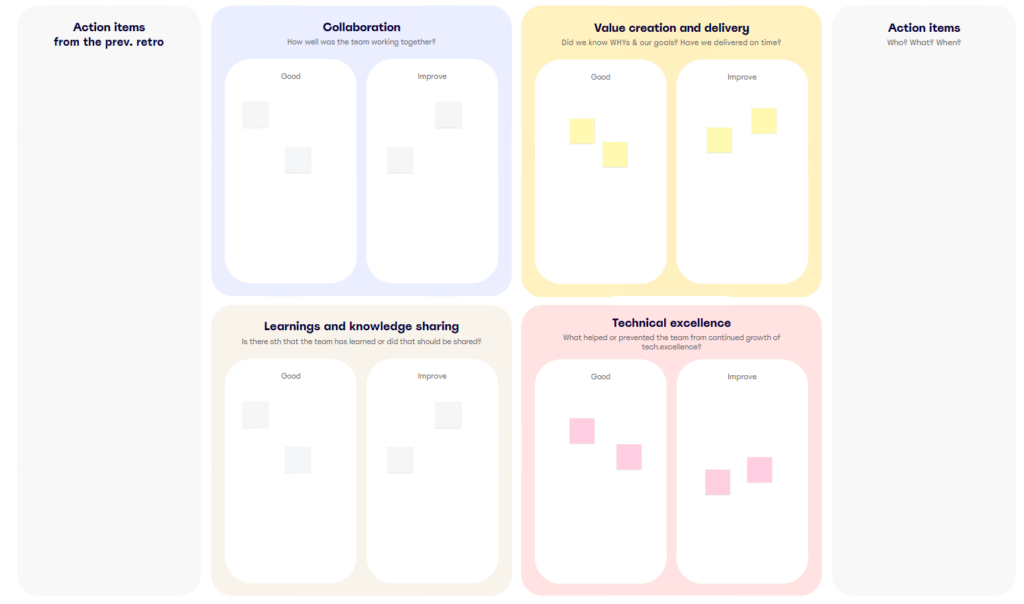
Week 47 • “The Silent”
Week : 47
Name : The Silent
Explanation : A silent retrospective has only one rule – no one is allowed to speak. Instead, collaboration is done by following a very simple process (more on that below).
How to run The Silent Retrospective?
In this template, I’ve added a quick check-in / check-out activity. Team members add their name to a sticky note and align it to their current energy level on the battery.
A quick ice breaker activity is included, to allow the facilitator to crowdsource the playlist for the retrospective.
In the Reflections section, the process is very simple:
- Write down problems that need solving
- Write down any questions or provide suggestions
- Write down any known actions to resolve the problem
What problems currently exist and need to be addressed? Write them in red stickies and add them below. When everyone is finished, then spend (enough) time to read over everything.
If anyone has a question, a suggestion, or needs clarification on a problem raised, write them on purple stickies and add them next to the red (problem) sticky.
If there is a known action to resolve the problem, then write it on a blue sticky and add it next to the red (problem) sticky. Continue this process of collaborative problem solving whilst time permits.
Each step is timeboxed, and no one is allowed to move onto the next step until the current one is completed by everyone.
Example:

Week 48 (Special Day) • “Thanksgiving”
Week 49 • “Climb”
Week : 49
Name : Climb
Explanation : Retrospective means looking back. This retrospective template helps teams to reflect on what worked well, what didn’t work well, and what they learned. In this template, we added a few other aspects, more specifically, the equipment, the atmosphere, etc…
The value of a retrospective lies in the initiatives and actions that follow the reflection and improve the team’s performance sustainably.
Example:
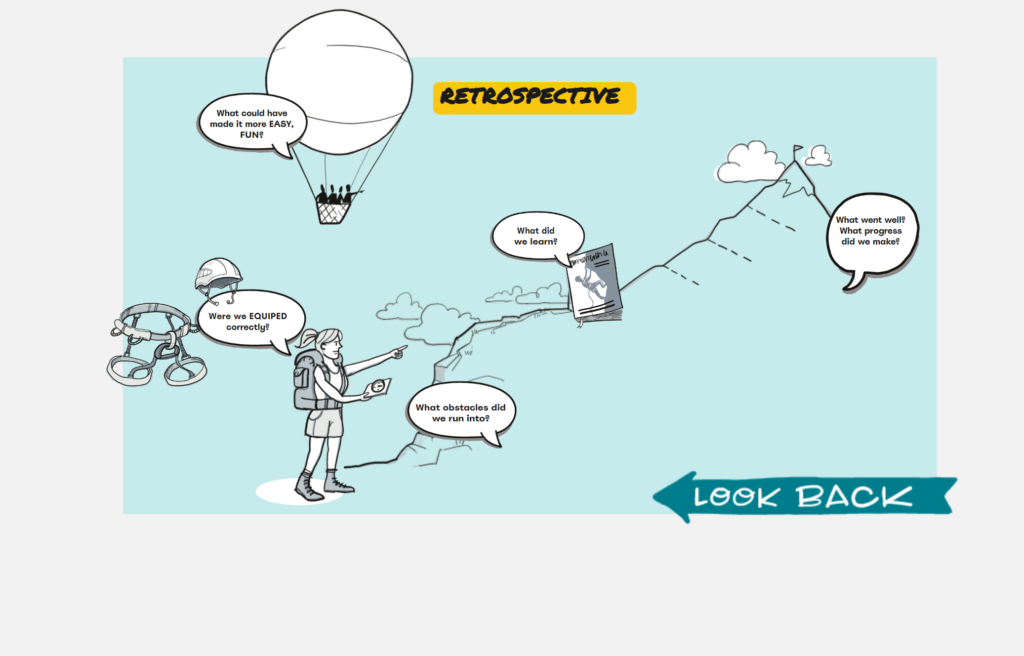
Week 50 • “Movie”
Week : 50
Name : Movie
Explanation : Request the team members to use sticky notes on the 4 topics
Back to the Future –
- Set a date in the DeLorean clock for the end of the next sprint?
- What do we hope to achieve?
- What knowledge will we have gained, assumptions tested or results delivered?
The Matrix –
- Blue pill or Red pill?
- How will we architect our new reality?
- How will we bring about the change we desire?
Jurassic Park –
- What’s the DNA of our sprint goal?
- What’s our hypothesis for what we think will happen?
- IF :
- WHEN :
- THEN :
James Bond –
- License to thrill.
- What will tell us that we’re adding value to our customers?
- What data or metrics do we need to measure?
As a bonus, why not encourage the team to visualise the next sprint as a movie or film character. These can easily be pulled into your workflow tool (JIRA, ADO et al) and remind the team of their goal.
Example:
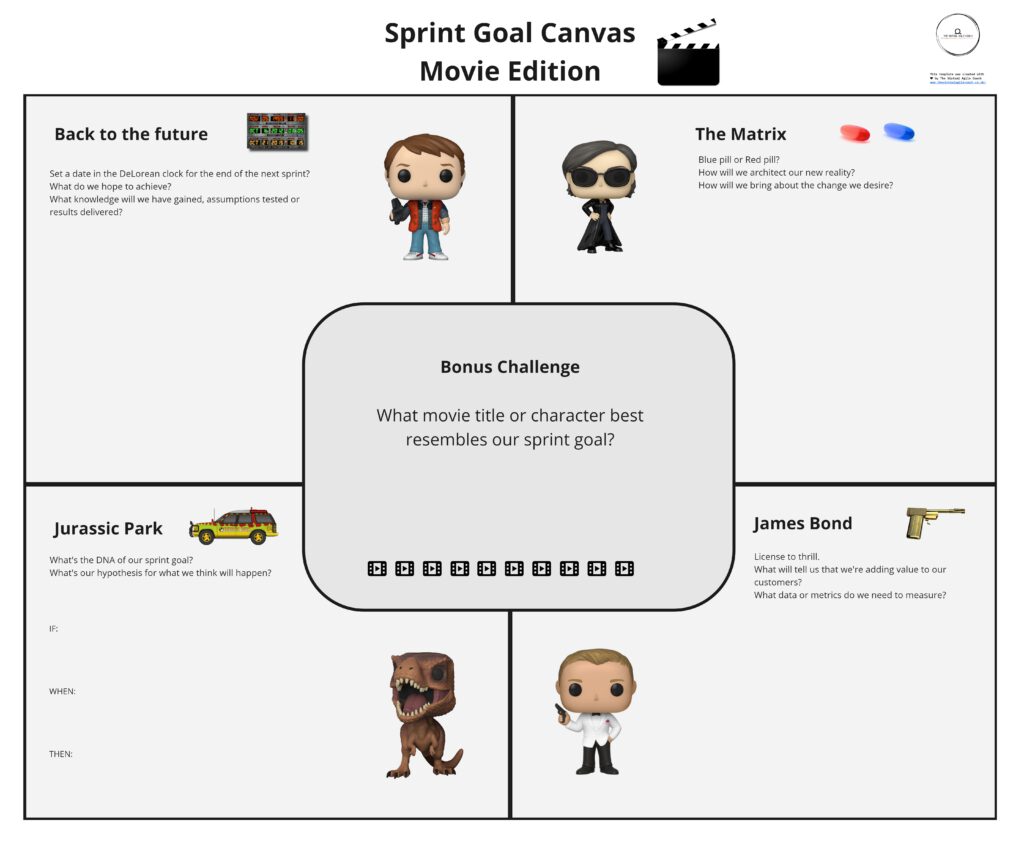
Source & Credit to : The Sprint Goal Canvas – Movie Edition | Virtually Agile
Week 51 • “Supermario”
Week : 51
Name : Super Mario
Explanation :
Agenda
- Opening (5 minutes)
• Welcome and introduction.
• Quick overview of the retrospective purpose.
• Review of the agenda. - Setting the Stage (10 minutes)
• Explain the ‘Super Mario’ theme and how it relates to the
retrospective aims. - Gather Data (20 minutes)
• Reflect on the last sprint/project phase.
• Ask each team member to write down their thoughts on sticky notes and place them in the respective columns:
– START DOING: New practices or strategies the team should adopt.
– STOP DOING: Ineffective actions or behaviors that should be discontinued.
– KEEP DOING: Successful actions or behaviors that should be maintained.
– ACTIONS: Specific steps or initiatives to take following the retrospective. - Generate Insights (15 minutes)
• Discuss the items in each column.
• Identify patterns or themes.
• Encourage the team to think about the ‘why’ behind
each item. - Decide What to Do (20 minutes)
• Prioritize the items that have been identified.
• Develop action items for the most important issues.
• Assign owners to each action item. - Closing (5 minutes)
• Recap the action items and owners.
• Gather feedback on the retrospective process.
• Thank everyone for their participation.
Example :

Week 52 (Special Day) • “Christmasday“
Week : 52
Name : Christmas Day
Explanation : The Scrum Master divides the board into 5 areas, namely:
- Where are you going from Sparkling?
- What comes as a surprise?
- What do you want to throw into the fire? (what you won’t go from today doing?)
- What next step(s) should we take?
- What gives you chills? (What doesn’t make you happy?)
Example :
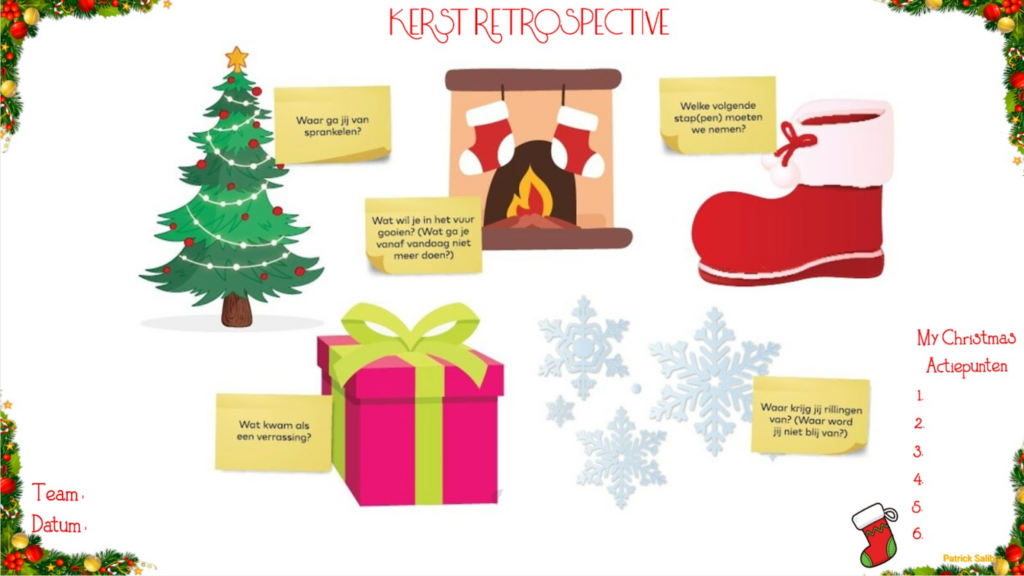
Extra (Special Event) • “EK Voetbal”
Uitleg
De Scrummaster verdeeld het board in 4 vakken, te weten:
- GOAL : Wat Ging Goed – Iets dat het team goed doet en dat moet worden behouden
- BIJNA GOAL : Wat Kon Beter – Iets wat we als team kunnen verbeteren
- WAT GING MIS : Dingen die mis gingen. Hoe kunnen we dat voorkomen
- DOEL & STRATEGIE : Ruimte voor nieuwe ideen
Stappenplan
- Bedenken/Maken van bevindingen over afgelopen sprint op post-its (7 minuten de tijd in private gedeelte)
- Elke team member laat zijn bevindingen zien en geeft kort en bondig uitleg (max 3 minuten p.p.)
- Gesprek om tot verbeteringen te komen.
- Distilleren van actiepunten
Example
